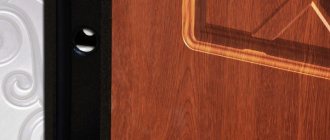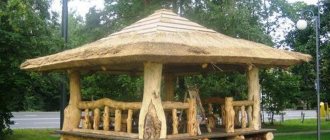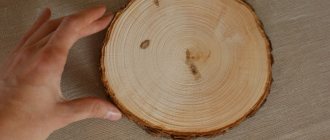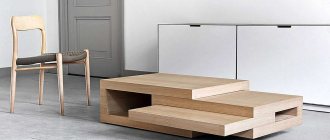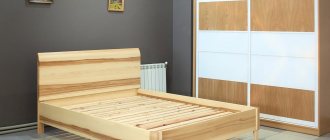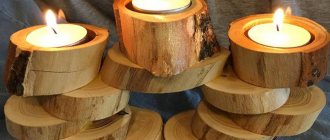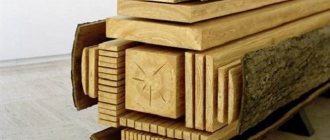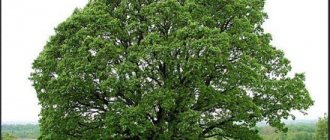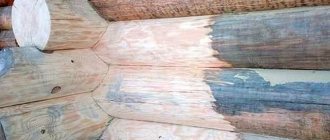What are slabs
The concept of “slab” comes from the English language; it does not directly refer to wood, but is translated as “slab, plate” in the broadest sense. It can mean a metal structure, a piece of stone, or a cut of wood.
A wood slab is a longitudinal (sometimes transverse) cut of an oak, elm, ash, poplar, or walnut trunk. This is an original, practical and environmentally friendly material that has gained immense popularity all over the world.
The cross-section of a tree reveals its nobility, pristine beauty and grandeur. After processing, the trunk does not lose its natural lines and contours, and the presence of small defects, imperfect shapes and knots only emphasizes its unique relief.
What is a slab and what is an array? Is there a difference?
What is a slab and what is an array? Is there a difference? In order to answer the question objectively, you need to understand what a slab is. So, a slab is a longitudinal cut of a single piece of wood. What is an array? This is clear from the name; an array is also a cut or section of a whole section of wood. So what's the difference? The report is simple - a slab and an array are essentially the same thing. A transverse cut of a tree can also be simply called an array. And a slab is always just a longitudinal section.
Each slab is exclusive - its texture contains the above-mentioned live edge, and fallen knots, and breaks in the texture that arose during the process of cutting, transporting or drying the wood, and sometimes even the passages of bark beetles. All these defects are carefully processed and filled with polyester resin, resulting in a smooth surface. Through the hardened resin you can see cracks, “craters” of fallen knots, and “tunnels” of beetles.
But what is an advantage for a slab is a disadvantage for an array. For the production of “extra” grade furniture board, only clean wood without knots and other wood defects is used.
The slabs are characterized by brutality and some roughness of form. Any product using a slab, be it a dining table, a console or a mirror frame, will be characterized by a massive shape, expressiveness and negligence, which not every style can withstand.
From furniture panels you can make an interior item in any style, be it baroque, modern or minimalism.
Natural decorative properties of slabs. Slabs are made from any type of wood, but most often they try to use valuable or unusual types of wood - oak, walnut, elm, ash, cherry, mountain poplar. Coniferous species, such as pine, cedar, larch, have a fairly calm, even texture. Only a knot, a twist, or a live edge can bring a picture to life. The texture of valuable wood species has a beautiful heterogeneous pattern and an interesting color palette. Depending on the type of wood, the slab can be from light, almost white, to dark brown. Colorless oil or varnish only emphasizes the natural beauty of wood.
Solid wood is also covered with colorless oil or varnish, but most often they prefer to tint or patina to give a more expensive and noble look to the product. The only exception is products made from solid walnut or mahogany, which have a very beautiful natural color. Using the example of slabs, you can see how a highly specialized, rarely used term has migrated into modern design. In almost any project in eco or loft style you can find a slab. A slab can be the basis of a project, creating the main accent, or a small inclusion that attracts the eye and enlivens even the most boring decor. One thing is certain - the slab has already entered the modern interior and, it seems, has settled in it for a long time.
If you want to order, for example, a table made of solid wood , a table made of slab, then we recommend that you feel free to contact us))
Features of the material
For cutting, as a rule, the lower part of the trunk is used - it is wider and stronger. The width of the workpiece can reach 1.5 m, and the thickness is usually 5–15 cm.
A real slab is considered to be a solid array, but in some cases it can be spliced from several cuts. The finished canvas can be supplemented with decorative inserts made of acrylic glass or layers of epoxy resin.
Wooden slabs have different sizes, shapes, and textures. It is impossible to find two identical saw cuts; each of them is unique and individual. Therefore, products made from solid wood are exclusive.
What are slabs made of?
Furniture made from slabs dramatically transforms even the most modest and austere interior. It has a special magnetism and pleasant tactility. Even a miniature coffee table with an original tabletop can become the main accent of a design concept. Most often, slabs are made from:
- dining tables, coffee tables, desks;
- ladies', tea, chess tables;
- consoles and trellises;
- headboards;
- bar counters;
- chairs, stools, benches;
- frames for mirrors and panels;
- window sills and shelves.
The range of products is limited solely by the imagination of the designer and the qualifications of the woodworking master. Separately, it is worth noting the spectacular designer furniture with figured glass inserts and epoxy layers.
Where are slabs used?
Most often, furniture is made from them, for example, dining tables, bar counters, cabinets, benches, shelves. Sometimes in the interior you can find a door or headboard made of solid wood. Some designers use them to frame mirrors, make lamps, and create sliding partitions.
An authentic wooden slab will emphasize the laconicism and minimalism of the loft space, support the cozy rustic style of a country house, and decorate a modern Scandinavian interior.
Reasons for the popularity of wood slabs
The popularity of wooden slabs is explained by the enduring fashion for naturalness and authenticity. Products made from them have a special natural energy and attractive brutality. It will be appreciated by both representatives of the rational young generation and experienced owners of a subtle artistic taste.
There are other reasons too.
- There is a natural need for maximum environmental friendliness, hypoallergenicity and naturalness.
- Originality and uniqueness of each product. Even from the same trunk it will not be possible to cut two absolutely identical pieces.
- Universal design. A table, stool, shelves made of slabs will organically fit into the interior of any style: loft, modern, minimalism, rustic, country, Scandinavian, etc.
- Out of fashion and time. The durability of valuable wood and the quality of its processing allow the use of slab products for several generations.
The modern fashion for furniture and interior items made from wooden slabs was introduced by designers working in the Live edge style. Its distinctive feature is the emphasis on the natural, genuine beauty of wood, preservation of natural geometry, knots, bark, cracks, etc.
DIY wooden slabs
Extraction and processing of wood slabs is a costly and labor-intensive process. It is almost impossible to do this with your own hands, without the use of technology. Cutting a massive trunk with a diameter of more than a meter, its storage, transportation, and drying require special equipment.
But you can try to make a slab yourself from a small log using a mini sawmill or chainsaw.
Granite slabs
Granite is a natural rock that has an exceptional appearance. It is a rock of igneous origin and contains quartz, the mineral orthoclase and a transparent layered mineral.
Thanks to the high strength and massiveness of granite stone, it is possible to produce beautiful products for the interior with huge parameters. The color of granite slabs of this natural stone is varied:
- red with a dark tint;
- blue;
- grayish.
The production of granite slabs is difficult, since it is a very hard stone, and granite slabs are difficult to cut into small pieces.
Slab granite is usually used when covering a large surface area, making columns, steps, cornices, cabinets, cladding slabs and others.
Technological stages of slab production
Harvested materials must be dried to the required moisture level. Drying can occur naturally in the open air or in special drying chambers under the influence of infrared irradiation or vacuum systems.
Chamber drying can cause significant drying stresses, which, in turn, lead to cracking, warping, and disruption of the structure and color of the wood. Slabs are especially susceptible to such processes due to the large thickness of the boards and their uneven drying.
To protect the surface and prevent the formation of cracks, treatment is carried out with stabilizers and small cuts are made in the slab. The need for such measures depends on the dimensions of the structure, as well as the type of wood used.
Subsequent steps involve removing the bark, calibrating the size, and filling the cracks with epoxy resin. The final stage is polishing the cut and covering it with a protective oil composition or a thin layer of varnish.
How are wood slabs used?
The popularity of slabs is inextricably linked with the triumph of such a design direction as Live edge. In this style, which can be literally translated as “Living Edge” or “Natural Edge,” furniture and other interior attributes are created. Live edge focuses on the authenticity of the wood and minimal interference in its natural forms: they preserve the natural geometry of the cuts, leave areas of bark, and emphasize knots, cracks, and grainy textures.
Slabs of wood are used to create massive tables, kitchen countertops, bar counters, cabinets and small coffee or coffee tables. Thinner cuts are used for the production of chairs, stools, and long benches (valuable species such as teak, etc. are especially in demand in this case). Slabs made of oak, elm, larch and other tree species are used to create window sills, shelving, and headboards.
A separate direction in the production of designer furniture is the combination of slabs with figuredly cut glass or a layer of epoxy resin. Typically, such solutions are used to create tables and countertops. The “flowing river” effect can be enhanced by adding phosphorescent additives to the epoxy resin.
You can see the polyphony of ideas for wooden furniture made from slabs in the photo in our gallery.
Caring for solid wood products
Excessive air dryness, excessive humidity, and sudden temperature changes can damage the unprotected wood texture and lead to cracking. Therefore, it is recommended to periodically carry out preventive treatment of products with wax, oil or other special compounds. This point is especially important if the furniture is located in the kitchen or bathroom.
When exposed to sunlight, the shade of the wood may change over time, but this will not have any effect on other characteristics.
Products should be wiped with a dry or damp soft cloth without using aggressive chemicals. With proper care, wooden products will retain their quality and impeccable appearance for a long time.
Drying prepared slabs
After studying the method of dissolving logs and choosing wood, you need to carefully familiarize yourself with drying methods. This is important, since the main part of the success of slab production depends on this stage. From a technological point of view, drying wood slabs with your own hands is done naturally in drying chambers.
Without using industrial equipment, drying prepared saw cuts is even easier. To do this you need to do the following:
- Choose a place. The room should not receive direct sunlight and should have a sufficient level of air dryness to make drying easier.
- Make a canopy under which the workpieces are stacked. It is important to leave air gaps.
